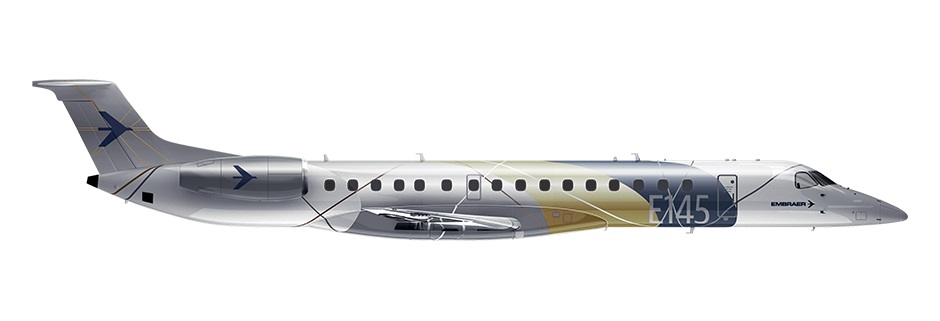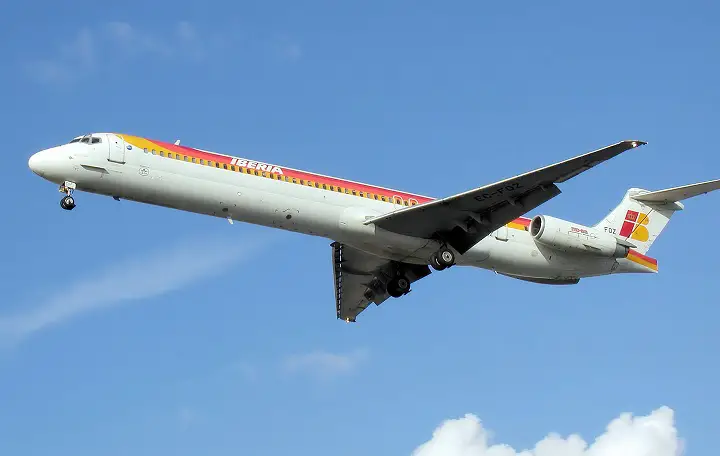
Embraer ERJ 145
Embraer ERJ 145 is a regional jet developed and produced by Embraer. ERJ 145, formerly known as EMB-145 “Amazon”, is Embraer’s first turbofan regional jet. ERJ 145 is also the world’s first jet regional aircraft designed specifically to meet the needs of regional aviation in specific markets, including high revenue generating capacity, low fuel consumption, low maintenance costs, and faster turnaround time.
The ERJ 145 passenger aircraft was developed based upon EM B-120 “Brasilia”. However, the new design uses a mid-bypass turbofan engine, the wings are redesigned and equipped with winglets , and the two engines are mounted on the tail section. The fuselage cross-section is the same as the EMB-120 however the fuselage is longer to accomodate more seating capacity.
Role: Twin-engine regional airliner
Manufacturer: Embraer
Country: Brazil
Status: In service
Variants
- ERJ 145
- ERJ 145ER
- ERJ145MR
- ERJ 145LR
- ERJ 145MP
- ERJ 145XR
- ERJ 145EP
- EMB 145AEW&C
- EMB 145RS
- EMB 145AGS
- EMB 145 MP / ASW
ERJ 145 is the basic variant. On December 10, 1996, the FAA certification was obtained with a maximum take-off weight of 19,200 kg.
ERJ 145ER is the extended range variant. On December 10, 1996, the FAA certification was obtained with a maximum take-off weight of 20,600 kg.
ERJ 145MR obtained the FAA certification with a maximum take-off weight of 22,000 kg on May 7, 1998. Only two aircraft of this type were produced, which were later transformed into the ERJ 145LR variant.
ERJ 145LR obtained FAA certification on May 7, 1998, with a full-load range of 3037 km, a maximum take-off weight of 22,000kg, increased fuel capacity and weight, and the use of an upgraded AE3007A1 turbofan engine to increase thrust by more than 15%.
ERJ 145MP has been used as a substitute for ERJ 145MR since 1999. The maximum take-off weight of ERJ 145MP is 20,990kg.
ERJ 145XR is the ultra long-range variant. It was launched at the 2000 Farnborough Airshow in the United Kingdom. The ERJ 145XR reinforces the fuselage and wing structure, and uses the Rolls-Royce/Allison AE3007A1E turbofan engine to reduce fuel consumption, improve high temperature, high altitude flight performance, and single engine flight altitude. The prototype of the aircraft made its first flight on June 29, 2001, and was approved by the Brazilian Airworthiness Authority on September 3, 2002. It was approved by the US FAA on October 22, 2002.
ERJ 145EP obtained the FAA certification on October 14, 2003. Its maximum take-off weight is 20,990 Kg, maximum landing weight is 18,700 kg, and maximum zero fuel weight is 17,100 kg.
EMB 145AEW&C is an ER-145LR high-altitude early warning and remote sensing aircraft developed for the Brazilian government. The Brazilian Air Force calls it R-99A. Five were ordered initially and the contract was signed in March 1997.
EMB 145RS is the high-altitude remote sensing aircraft variant. The Brazilian Air Force calls it R99B. Delivery began in the first quarter of 2001. The aircraft is mainly utilized in performing tasks such as natural resource exploration, environmental and river pollution monitoring etc.
EMB 145AGS is equipped with systems to carry out military missions.
Specifications
External Dimensions
Length: 29.87 meters
Height: 6.75 meters
Fuselage length: 27.93 m
Fuselage width: 2.28 m
Wingspan: 20.04 m
Horizontal tail wing span: 7.55 m
Aspect ratio: 7.9
Wing area: 51.18 m²
Main wheelbase: 4.10 m
Front and rear wheel track: 14.45 m
Cabin door (height×width): 1.70 m×0.71 m
Service door (height×width): 1.42 m×0.62 m
Luggage compartment door (height×width): 1.12 m×1.00 m
Emergency hatch (height×width): is 0.92 m×0.51 m
Internal Dimensions
Cabin (including luggage compartment, excluding the cockpit): 16.49 meters
Maximum height: 1.82 meters
Maximum width: 2.10 meters
Floor area: 25.7 m²
Volume: 53 m³
Weight and Load
Empty weight: 12100 kg
Maximum take-off weight: 22,000 kg
Maximum landing weight: 19,300 kg
Maximum fuel load: 5187 kg
Performance Data
Maximum cruising speed: 833 km/h
Service Ceiling: 11,275 meters
Take-off field length (sea level): 1970 meters
Landing field length (sea level): 1390 meters
Range (full load): 3000 km (1650 nmi)







